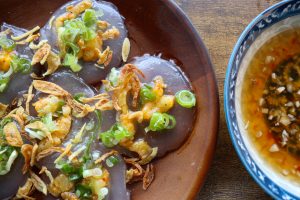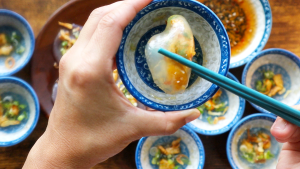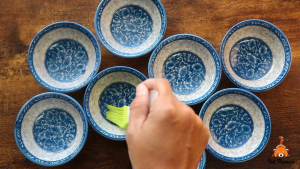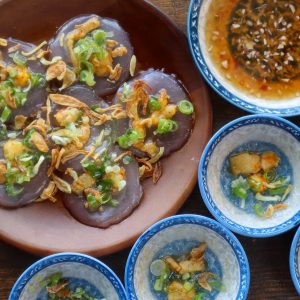Vietnamese Steamed Tapioca Dumplings (Bánh Bột Lọc)

Vietnamese Steamed Tapioca Dumplings, known as Bánh Bột Lọc, are small, translucent, and delightfully chewy dumplings that are a beloved part of Vietnamese cuisine. Often enjoyed as appetizers or snacks, these dumplings are typically filled with shrimp and pork belly, then topped with fried shallots and served alongside a sweet chili fish sauce. The dish is believed to have originated in Huế, the former imperial capital during the Nguyễn dynasty, a city renowned for its cuisine that combines simplicity with sophistication.
Bánh Bột Lọc can be prepared in two main ways: steamed or boiled, with or without a banana leaf wrapping. When wrapped in banana leaves, it is called Bánh Bột Lọc Lá (with “lá” meaning “leaf”), while the version without the wrapping is known as Bánh Bột Lọc Trần (“trần” meaning “bare”). Regardless of the preparation method, these dumplings deliver an elegant appearance, much like other dishes from Huế, and a taste that’s simply irresistible.
Outside of Vietnam, Bánh Bột Lọc is not commonly found on the menus of most Vietnamese restaurants. Though it may appear simple, the dish is considered quite tedious to make, primarily due to the time and effort required to prepare the tapioca flour for the dough. In this recipe, I’ll show you a technique that simplifies the process, eliminating the need for kneading and wrapping, while still yielding delicious dumplings that rival those made with the traditional method.
Here are a few notes on my Vietnamese Steamed Tapioca Dumplings recipe:
- My method for making Bánh Bột Lọc is unconventional and simplified. You won’t need banana leaves (or any other wrapping materials), nor will you need to knead, cut, and shape individual dumplings. There’s also no boiling involved. All you need are several saucers (like the ones used for my Bánh Bèo recipe) and a steamer. This approach is ideal for those short on time or anyone who may find kneading dough by hand difficult.
-

My recipe simplifies the preparation, using saucers for uniform shaping and eliminating the need for kneading and wrapping Another advantage of this approach is that it ensures uniformity in the appearance of the Bánh Bột Lọc, as the saucers act as moulds. Additionally, there is no risk of the dumplings bursting during boiling, since steaming is used instead.
- The steaming time for Bánh Bột Lọc can vary depending on the size of the saucers and the desired thickness of the dumplings. I recommend doing a couple of test runs before steaming the dumplings in larger batches to get the timing just right.
- Once steaming is complete, allow the dumplings to cool significantly before removing them from the saucers. This makes it easier to take them out (and fold them, if you like) before transferring them to a serving plate. Alternatively, you can leave the dumplings in the saucers and serve them directly as “Bánh Bột Lọc Chén,” where “chén” means “small bowl” or “saucer.”
Q&As on Vietnamese Steamed Tapioca Dumplings

1. I’m shopping for tapioca flour to make my Bánh Bột Lọc, but I’m seeing both “tapioca flour” and “tapioca starch” on different brands. Are they the same thing?
Yes, tapioca flour and tapioca starch are actually the same product. In most cases, the terms are used interchangeably, and both refer to the fine powder made from the cassava root. Tapioca flour/starch is a key ingredient in many Vietnamese dishes, including Bánh Bèo, as it provides the chewy texture that is essential for the dish. When shopping, you can confidently use either “tapioca flour” or “tapioca starch” for your recipe, as there is no difference in quality or performance.
2. Can I place raw shrimp and pork belly pieces directly in the saucers? Will the dumplings cook properly?
While the dumplings will cook during steaming, it’s best to cook the shrimp and pork belly beforehand. Pre-cooking the filling ensures the meat is fully cooked, well-seasoned, and flavourful. It also helps prevent excess moisture from the raw ingredients, which can affect the texture of the dumplings. For the best results, sauté the shrimp and pork belly with your preferred seasonings before adding them to the saucers.
3. I saw ready-made flour for Bánh Bột Lọc at my local Asian supermarket. Can I use this instead of plain tapioca flour as listed here?
Yes, you can use the ready-made flour mix for Bánh Bột Lọc, but be aware that it may come with specific instructions for preparing the batter or dough. The recommended preparation methods might differ from the traditional recipe, including whether to steam or boil the dumplings. Be sure to follow the instructions on the package for the best results, as they are designed to optimize the flour mix’s performance.
4. I saw ready-made flour for Bánh Bột Lọc at my local Asian supermarket. Can I use this instead of plain tapioca flour as listed here?
Yes, you can use the ready-made flour mix for Bánh Bột Lọc, but keep in mind that it may come with specific instructions for preparing the batter or dough, as well as guidelines on whether to steam or boil the dumplings. In my recipe, I used plain tapioca flour, which has been thoroughly tested to achieve the desired results using the preparation method described here. I can’t guarantee that the ready-made flour mix will produce the same results, as it may require different techniques. For the best outcome, be sure to follow the package instructions if you choose to use the ready-made mix.
5. What saucer size is ideal for Bánh Bột Lọc?
The choice of saucer size is strictly a matter of personal preference. I personally use saucers that are 3.25 inches in diameter and about 1.25 inches in depth. These produce dumplings that are approximately 2.25 inches in diameter. For more details on saucer sizes, you can visit my post on Bánh Bèo, where I discuss this topic further.

6. I’m having trouble removing the Bánh Bột Lọc from the saucers. What might be the issue?
There are two possible reasons why the Bánh Bột Lọc might be difficult to remove from the saucers.
First, the saucers may not have been greased thoroughly. Make sure to coat them with a sufficient amount of oil before steaming. If you’re reusing the saucers for another batch, remember to grease them again to prevent sticking.
The second reason could be that you’re trying to remove the dumplings while they are still hot. When hot, the dumplings are stickier and more challenging to remove smoothly. Allow them to cool down a bit more, and they should come out of the saucers more easily.
7. How do I know if my dumplings are cooked through?
For this recipe, perfectly cooked Bánh Bột Lọc will have a transparent dough, with no white spots remaining. The dumplings should also be very tender and have a pleasantly chewy texture. If the dough is still opaque or the dumplings feel too firm, they may need a bit more steaming time.
8. How do you pronounce “Bánh Bột Lọc?”
“Bánh Bột Lọc” is pronounced as bahn boht lock. Here’s a breakdown to help you:
- “Bánh” sounds like bahn (with a short “a” as in “cat”).
- “Bột” is pronounced like boht (rhyming with “boat,” but with a shorter “o” sound).
- “Lọc” sounds like lock (similar to “lock,” with a slightly softer “l”).
Try saying it smoothly, with each word flowing into the next.

Recipe for Vietnamese Steamed Tapioca Dumplings (Bánh Bột Lọc)
Equipment
- 1 medium nonstick skillet
- 1 steamer
Ingredients
For the Batter:
- 400 grams tapioca flour
For the Filling:
- 300 grams pork belly
- 275 grams shrimp (peeled and deveined)
- 1 tablespoon minced garlic
- 1 tablespoon minced shallots
- Seasoning: Salt, MSG (or chicken bouillon powder), ground black pepper
- Annatto oil (for colour), kimchi red pepper powder optional
For the Green Onion Oil:
- ¼ cup cooking oil
- ¾ cup finely chopped green onions
Instructions
- Prepare the Filling:Dice the shrimp into small, even pieces, and cut the pork belly into short, thin strips for consistent cooking.Season the shrimp and pork belly with a generous pinch of salt, a bit of MSG (or chicken bouillon powder), and some freshly ground black pepper. Mix everything well to evenly distribute the seasonings, then let the mixture marinate for 15 minutes to allow the flavours to absorb.In a medium nonstick skillet, heat a small amount of oil over high heat until it shimmers. Add the minced garlic and shallots, stirring constantly to sauté until they become fragrant and slightly golden.Add the pork belly to the skillet and sauté for a few minutes, stirring frequently. Then add the diced shrimp, mixing them together thoroughly to combine.If desired, add a small amount of annatto oil for a rich, vibrant colour, and a pinch of kimchi red pepper powder (optional) for a touch of spice. Stir to coat the mixture evenly.Once the pork and shrimp are fully cooked through, remove them from the heat and transfer the mixture to a strainer. Allow any excess liquid to drain off, so the filling becomes dry and concentrated in flavour.
- Prepare the Green Onion Oil:In a small skillet, heat 1/4 cup of cooking oil over medium-high heat. Once the oil is hot, carefully pour it over the finely chopped green onions in a separate bowl. Stir to mix and release the onion's aroma, then set the mixture aside.
- Prepare the Batter:In a large mixing bowl, combine the tapioca flour with 1/2 tablespoon of salt, 1/2 tablespoon of cooking oil, and 800 mL of water. Mix thoroughly until the batter is smooth and free of lumps.Cover the bowl with a lid or plastic wrap and let the batter rest for 30 minutes to allow the tapioca flour to fully hydrate.
- Steam the Dumplings:Grease several saucers generously to ensure the dumplings do not stick. Set up a steamer and arrange the greased saucers inside, making sure they are evenly spaced to allow the steam to circulate.Give the batter a good stir before using. Pour 1 tablespoon of batter into each saucer, just enough to form a thin, even layer across the bottom.Place a portion of the filling in the centre of each saucer, nestling it gently into the batter.Steam the dumplings for approximately 5 minutes, or until the batter turns translucent and glossy. Remove the saucers from the steamer and allow them to cool significantly before handling.Use chopsticks to gently lift the dumplings from the saucers, taking care not to tear the delicate dough.Repeat the steaming process until all the batter and filling have been used up.
- Serve:Drizzle the prepared green onion oil over the dumplings, and sprinkle fried shallots on top if desired for extra flavour and crunch.Serve the dumplings with the prepared dipping sauce, and enjoy your delicious Vietnamese Steamed Tapioca Dumplings (Bánh Bột Lọc Trần) while they’re still warm!

